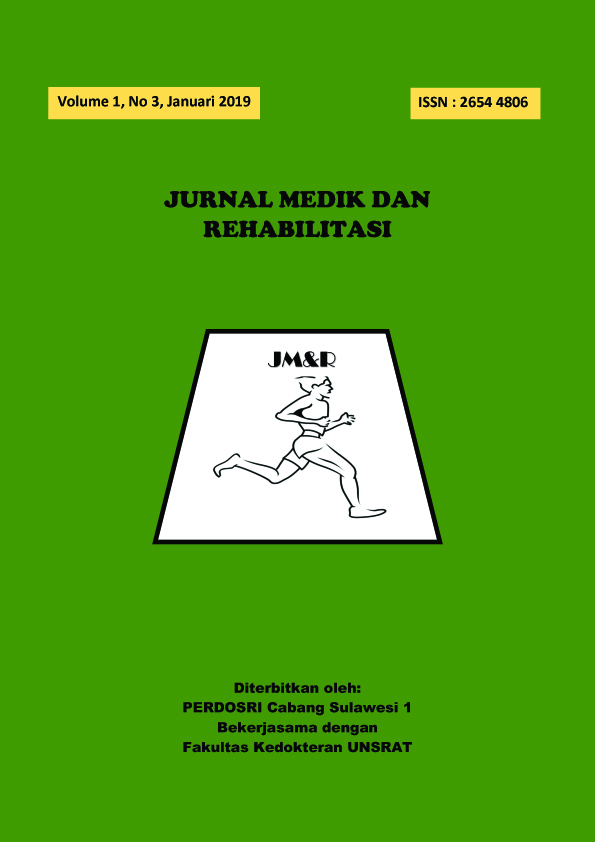HUBUNGAN ANTARA USIA DAN DERAJAT KERUSAKAN SENDI PADA PASIEN OSTEOARTRITIS LUTUT DI INSTALASI REHABILITASI MEDIK RSUP. PROF. DR. R. D. KANDOU MANADO PERIODE JANUARI – JUNI 2018
Abstract
Abstract: Osteoarthritis (OA) is one of the most common diseases in the world. This disease causes pain and disability and interferes the patient’s daily activities. Osteoarthritis is divided into two groups, primary and secondary osteoarthritis. OA is an inflammation of the joint that mostly effects 60% male and 70% female at age >65. Joint damage can be found on every part of the body, it can also damage the synovial and cartilage around the bone. Theres a lot of risk factors of OA such as age, gender, ethnicity, genetics, congenital, diet, obesity, trauma or risk operation history, sports, mechanic factors, knee weakness and malalignment. The aim of this study is to identify the correlation between age and damage degree of OA patients admitted to Medical Rehabilitation Department at Prof. Dr. R. D. Kandou hospital Manado. This study was a retrospective analytic study with cross sectional design with data taken from medical records. From medical records data, the amount of patients that qualifies the inclusion criteria is 34 patients with OA as the main diagnose and 19 patients with K-L degree. The result obtained from this study showed that incidence rate of knee OA is highest at the age 60 – 75 years (74%). Conclusion: The prevalence of knee OA increased with aging.
Â
Keyword: Knee Osteoarthritis, Age, Joint damage.
Abstrak: Osteoartritis (OA) merupakan penyakit yang paling banyak ditemukan di dunia. Penyakit ini menyebabkan nyeri dan disabilitas pada penderita sehingga mengganggu aktivitas sehari – hari. Terdapat 2 kelompok osteoartritis, yaitu osteoartritis primer dan osteoartritis sekunder. OA adalah radang sendi yang paling banyak terjadi dan merupakan suatu penyakit progresif yang mempengaruhi 60% pria dan 70% wanita >65 tahun. Kerusakan sendi dapat terjadi di semua bagian tubuh, kerusakan terjadi di sinovium dan tulang rawan sekitar tulang.Banyak faktor risiko yang mempengaruhi OA seperti, usia, jenis kelamin, ras, genetik, kongenital, diet, obesitas, riwayat trauma atau operasi lutut, kegiatan olahraga, faktor mekanis, kelemahan lutut dan malalignment lutut. Penelitian ini bertujuan mengetahui hubungan antara usia dan derajat kerusakan sendi pada pasien OA lutut di Instalasi Rehabilitasi Medik RSUP. Prof. Dr. R. Kandou Manado. Jenis penelitian metode teran analitik retrospektif dengan pendekatan cross sectional dengan pengumpulan data yang diambil dari rekam medis. Dari data rekam medik yang memenuhi kriteria inklusi yaitu diagnosis OA lutut hanya 34 orang dan yang memiliki nilai K-L hanya 19 orang. Hasil yang didapatkan menunjukkan bahwa angka kejadian OA lutut paling tinggi pada usia 60 – 75 tahun (74%). Simpulan: Terdapat peningkatan prevalensi osteoartritis lutut seiring dengan pertambahan usia.
Kata Kunci: Osteoartritis lutu, Usia, Kerusakan sendi.
References
Kohn MD, Sassoon AA, Fernando ND. Classifications in Brief: Kellgren-Lawrence Classification of Osteoarthritis. Clinical Orthopaedics and Related Research® 2016;474:1–3.
Hendrati LY, Anggraini NE. Hubungan Obesitas dan Faktor – Faktor Pada Individu dengan Kejadian Osteoarthritis Genu. Jurnal Berkala Epidemiologi 2014 Januari;2:93.
Osteoarthritis Research Society International. 2016. Osteoarthritis : A serious disease, submitted to the U.S food and drug administration. https://www.oarsi.org/sites/default/files/docs/2016/oarsi_white_paper_oa_serious_disease_121416_1.pdf.
Perhimpunan Reumatologi Indonesia. Rekomendasi IRA untuk diagnosis dan penatalaksanaan osteoarthritis. Jakata;2014.
Fransen M, Bridgett L, March L, Hoy D, Penserga E, Brooks P. The epidemiology of osteoarthritis in Asia. International Journal of Rheumatic Diseases 2011;14:113-9.
Kasper DL, Fauci AS, Hauser SL, Longo DL, Jameson JL, Loscalzo J. Harrisons principles of internal medicine. 19th ed. New York: Mc Graw Hill education; 2015.h.2226-23.
Samson DJ, Grant MD, Ratko TA, Bonnell CJ, Ziegler KM, Aronson N. Treatment of Primary and Secondary Osteoarthritis of the Knee. Chicago: 2007.h.25.
Nguyen TV. Osteoarthritis in southeast Asia. International Journal of Clinical Rheumatology 2014;9:405–7.
Correction:Translation of clinical problems in osteoarthritis into pathophysiological research goals. RMD Open 2016;2:1–4.
Zhang Y, Jordan JM. Epidemiolgy of Osteoarthritis 2010.h.355-63.
Anderson AS, Loeser RF. Why is osteoarthritis an age-related disease? Best Practice & Research Clinical Rheumatology 2010;24:15–7.
Felson DT, Naimark A, Anderson J, Kazis L, Castelli W, Meenan RF. The prevalence of knee osteoarthritis in the elderly. the framingham osteoarthritis study. Arthritis & Rheumatism 1987;30:914–8.
Deshpande BR, Katz JN, Solomon DH, Yelin EH, Hunter DJ, Messier SP, et al. Number of Persons With Symptomatic Knee Osteoarthritis in the US: Impact of Race and Ethnicity, Age, Sex, and Obesity. Arthritis Care & Research 2016;68:1743–50.
Loeser RF. Transactions of the American Clinical and Climatological Association. The Role of Aging In the Development of Osteoarthritis 2017;128:44–54.

